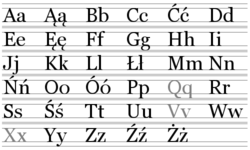Your cart is currently empty!
Learn Polish for beginners – something which can feel overwhelming, especially if you don’t have prior experience with Slavic languages. The good news? You don’t need to learn everything perfectly to pass the B1 exam. I followed a structured approach that worked for me, and while it may not be perfect, it helped me succeed—so it might work for you too!
Step 1: Learn Polish for Beginners – Alphabet and Special Characters
Polish uses Latin script but includes additional special characters (ą, ć, ę, ł, ń, ó, ś, ź, ż). It’s crucial to recognize them, but don’t stress too much over the differences between z, ź, and ż in the beginning. Yes, pronunciation is important, but these distinctions take time to master. Instead, focus on:
- Familiarizing yourself with the special characters.
- Listening to their pronunciation.
- Practicing them slowly until they become natural.
Step 2: Learn Basic Greetings and Self-Introductions
Once you recognize Polish letters and sounds, move straight into practical usage. This helps you to Learn Polish for beginners, Start with:
- Common greetings: Cześć (Hi), Dzień dobry (Good day), Dobry wieczór (Good evening).
- Self-introduction phrases: Nazywam się… (My name is…), Jestem z… (I am from…), Mam … lat (I am … years old).
- Basic polite expressions: Dziękuję (Thank you), Proszę (Please), Przepraszam (Sorry/Excuse me).
These phrases introduce you to various grammar forms, but don’t stress over them yet—just memorize and use them confidently.
Step 3: Memorize Numbers (They’re Easier Than You Think!)
Numbers are essential in daily life and relatively easy to learn especially to Learn Polish for beginners. Focus on:
- Counting from 1 to 100.
- Practicing phone numbers, prices, and dates.
- Making flashcards to reinforce memory.
Try using Polish numbers whenever possible—like reading prices at the store or saying the time out loud.
Step 4: Reinforce Learning Through Daily Practice
Learning is one thing; using the language is another. To build confidence:
- Use Polish greetings when meeting people.
- Practice self-introduction in front of a mirror.
- Try to recall Polish numbers whenever you see numbers around you.
Conclusion: How Beginners Can Learn Polish Faster
This basic foundation shouldn’t take more than a few days to complete on your journey to Learn Polish for beginners. The key is consistency—daily exposure and practice will make a huge difference. Once you feel comfortable with these basics, you’ll be ready to move on to more complex aspects of the language.
Stay committed, don’t fear mistakes, and keep pushing forward. Good luck on your Polish-learning journey!
Continue now with Lesson 2 by clicking the link below.
🎧 You can practice listening with Real Polish or watch beginner-friendly videos on YouTube – Learn Polish for Beginners.
🧩 Want to learn 300+ essential Polish verbs with examples and grammar cases? Buy our Polish Verb Flashcards here – perfect for B1 learners!
📲 Follow us on Instagram for daily tips and reels: @pass_b1
How long does it take to learn Polish B1?
It depends, but with daily practice and proper materials like flashcards and lessons, many learners reach B1 in 6–12 months.
Do I need to speak perfectly to pass B1?
No, B1 requires clear communication, not perfection. Focus on consistency and confidence.
What’s the best way to start learning Polish?
Begin with the alphabet, greetings, numbers, and daily usage — just like in this lesson.


Leave a Reply
You must be logged in to post a comment.